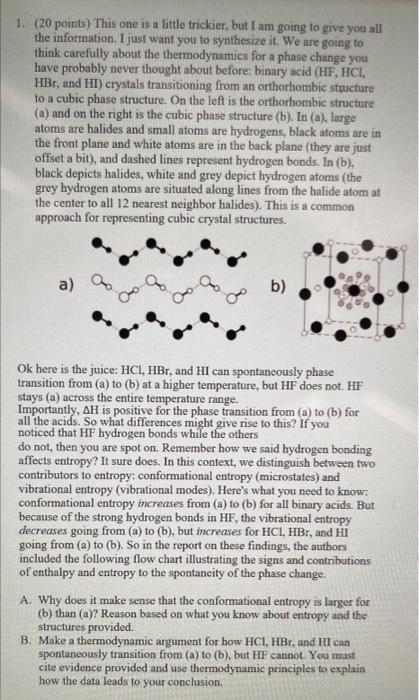1. (20 points) This one is a little trickier, but I am going to give you all the information. I just want you to synthesize it. We are going to think carefully about the thermodynamics for a phase change you have probably never thought about before: binary acid (HF, HCI, HBr, and HI) crystals transitioning from an orthorhombic stucture to a cubic phase structure. On the left is the orthorhombic structure (a) and on the right is the cubic phase structure (b). In (a), large atoms are halides and small atoms are hydrogens, black atoms are in the front plane and white atoms are in the back plane (they are just offset a bit), and dashed lines represent hydrogen bonds. In (b), black depicts halides, white and grey depict hydrogen atoms (the grey hydrogen atoms are situated along lines from the halide atom at the center to all 12 nearest neighbor halides). This is a common approach for representing cubic crystal structures. a) e b) Ok here is the juice: HCI, HBr, and HI can spontaneously phase transition from (a) to (b) at a higher temperature, but HF does not. HF stays (a) across the entire temperature range. Importantly, AH is positive for the phase transition from (a) to (b) for all the acids. So what differences might give rise to this? If you noticed that HF hydrogen bonds while the others do not, then you are spot on. Remember how we said hydrogen bonding affects entropy? It sure does. In this context, we distinguish between two contributors to entropy: conformational entropy (microstates) and vibrational entropy (vibrational modes). Here's what you need to know: conformational entropy increases from (a) to (b) for all binary acids. But because of the strong hydrogen bonds in HF, the vibrational entropy decreases going from (a) to (b), but increases for HCI, HBr, and HI going from (a) to (b). So in the report on these findings, the authors included the following flow chart illustrating the signs and contributions of enthalpy and entropy to the spontaneity of the phase change. A. Why does it make sense that the conformational entropy is larger for (b) than (a)? Reason based on what you know about entropy and the structures provided B. Make a thermodynamic argument for how HCI, HBt, and I can spontaneously transition from (a) to (b), but HF cannot. You must cite evidence provided and use thermodynamic principles to explain how the data leads to your conclusion







